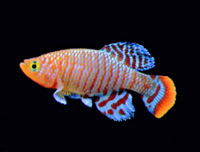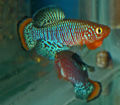Difference between revisions of "Nothobranchius rachovii"
From The Aquarium Wiki
m |
|||
| Line 35: | Line 35: | ||
|max_water_hardness=10 | |max_water_hardness=10 | ||
}} | }} | ||
| − | + | ||
| − | + | == Sexing == | |
| − | + | :Males have more vivid colouration and longer finnage than females. | |
| − | + | ||
| − | + | ||
| − | + | == Tank compatibility == | |
| − | + | :These fish should only be kept in species tanks. Males can be quite aggressive towards one another, if two are to be kept you'll need a very spacious tank. Keep females in the ratio of 2-3 females per male as the females will be heavily pursued. | |
| − | + | ||
| − | + | ||
| + | == Diet == | ||
| + | :These fish should not be fed dried foods if it can be avoided, they do much better on live/frozen food such as [[brine shrimp]], [[daphnia]] and [[bloodworm]]. | ||
| + | |||
| + | |||
| + | == Feeding regime == | ||
| + | :Feed once or twice a day. | ||
| + | |||
| + | |||
| + | == Environment specifics == | ||
| + | :These fish need quite a specific set up in order to be kept successfully and breed. They need a mature tank with a dark substrate, preferably peat moss, as well as dense planting and bogwood décor. Floating plants will help diffuse light as they do not appreciate bright lighting. A tight-fitting cover is a must as these fish can jump. | ||
| + | |||
| + | |||
| + | == Behaviour == | ||
| + | :An annual Killifish that can be nippy and territorial. | ||
| + | |||
| + | |||
| + | == Identification == | ||
| + | :A very attractive fish, its body is red-orange in base colour, overlaid with iridescent blue scales. The dorsal, anal and pelvic fins are blue with red markings. The caudal fin has a thick orange band and edged with a black band. There are selective-bred colour variations seen also. | ||
| + | |||
| + | |||
{{Categories | {{Categories | ||
|Category=Fish, Fish (Freshwater), Killifish | |Category=Fish, Fish (Freshwater), Killifish | ||
Latest revision as of 03:15, 13 December 2017
Bluefin Notho
Nothobranchius rachovii
38 Litres (10 US G.)
3.8-5.1cm (1.5-2 ")
Freshwater
6.0 - 7.0
20-23.9°C (68 -75 °F)
3-10 °d
1:1 M:F
1-2 years
Family
Nothobranchiidae
Contents
Additional names
- Bluefin Notho, Bluefin Nothobranch
Sexing[edit]
- Males have more vivid colouration and longer finnage than females.
Tank compatibility[edit]
- These fish should only be kept in species tanks. Males can be quite aggressive towards one another, if two are to be kept you'll need a very spacious tank. Keep females in the ratio of 2-3 females per male as the females will be heavily pursued.
Diet[edit]
- These fish should not be fed dried foods if it can be avoided, they do much better on live/frozen food such as brine shrimp, daphnia and bloodworm.
Feeding regime[edit]
- Feed once or twice a day.
Environment specifics[edit]
- These fish need quite a specific set up in order to be kept successfully and breed. They need a mature tank with a dark substrate, preferably peat moss, as well as dense planting and bogwood décor. Floating plants will help diffuse light as they do not appreciate bright lighting. A tight-fitting cover is a must as these fish can jump.
Behaviour[edit]
- An annual Killifish that can be nippy and territorial.
Identification[edit]
- A very attractive fish, its body is red-orange in base colour, overlaid with iridescent blue scales. The dorsal, anal and pelvic fins are blue with red markings. The caudal fin has a thick orange band and edged with a black band. There are selective-bred colour variations seen also.
Pictures[edit]
External links[edit]
- Fishbase (Mirrors:
 )
)

